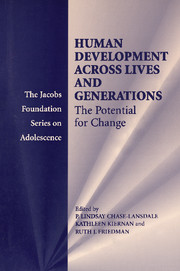Book contents
- Frontmatter
- Contents
- Figures and Tables page
- Contributors
- Foreword
- Acknowledgments
- HUMAN DEVELOPMENT ACROSS LIVES AND GENERATIONS
- Part I Introduction and Overview
- Part II Human Capital
- Part III Partnership Behavior
- Part IV Psychological Health and Development
- 9 Intergenerational Continuities and Discontinuities in Psychological Problems
- 10 Environmental Influences on Intellectual Abilities in Childhood: Findings from a Longitudinal Adoption Study
- 11 Intervention and Policy as Change Agents for Young Children
- Part V Conclusion
- Index
11 - Intervention and Policy as Change Agents for Young Children
from Part IV - Psychological Health and Development
Published online by Cambridge University Press: 12 October 2018
- Frontmatter
- Contents
- Figures and Tables page
- Contributors
- Foreword
- Acknowledgments
- HUMAN DEVELOPMENT ACROSS LIVES AND GENERATIONS
- Part I Introduction and Overview
- Part II Human Capital
- Part III Partnership Behavior
- Part IV Psychological Health and Development
- 9 Intergenerational Continuities and Discontinuities in Psychological Problems
- 10 Environmental Influences on Intellectual Abilities in Childhood: Findings from a Longitudinal Adoption Study
- 11 Intervention and Policy as Change Agents for Young Children
- Part V Conclusion
- Index
Summary
Prevention and Intervention strategies for young children are based on the premise that it is possible to alter outcomes such as cognitive, emotional, and social skills as well as school achievement and risky behavior in children and youth. Theoretical perspectives on development are based on a similar expectation. However, model-building and program-building approaches do come from different traditions. And, knowledge from one is often not applied to the other. The disconnect between intervention and theory deprives both of relevant insights as well as the possibility to refine (and perhaps refocus) the ways in which development is conceptualized. How do the findings from the early childhood intervention literature, as reviewed in this chapter, inform theoretical perspectives on young children's development?
In this chapter, several bodies of literature are reviewed — early childhood education programs, home-visiting programs, and the quality of child care programs (which is a distinct literature from the early childhood education literature). The goals (sometimes implicit and sometimes explicit) and the curriculum or program approaches are first considered, based on the existing literature. Whenever possible, programs that are based on random assignment are highlighted. All but the child care quality literature is based on controlled experiments, which allows for causal inference. Problems of selection bias in the child care research are discussed. Techniques are discussed for limiting selection bias in child care research as well as in studies of dose of an intervention (when different groups are not assigned in a random fashion to various intensities of treatment, an approach almost never taken).
Then, short-term and long-term effects of the types of programs are reviewed. The outcomes of interest cover the gamut of child development. In reality, most of the work focuses on achievement quite narrowly defined (e.g., IQ, school achievement, grade retention, high school graduation). Whenever possible, evidence on outcomes in the social and emotional realm are discussed (e.g., behavior problems, delinquency, peer relationships, teenage pregnancy).
Attention is paid to the question of who benefits from particular programs as well as what features of programs might be most relevant. Relationships among children and staff as well as parents and staff are also considered, given the centrality of relationships in developmental research. To a lesser extent, comparisons between the dimensions of effective staff (teachers, child care Providers, home visitors) and competent parents are made.
- Type
- Chapter
- Information
- Human Development across Lives and GenerationsThe Potential for Change, pp. 293 - 340Publisher: Cambridge University PressPrint publication year: 2004
- 25
- Cited by



